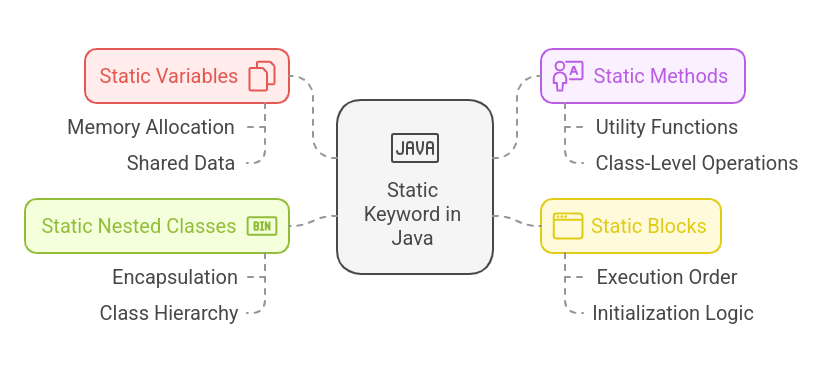The static keyword is a critical feature in Java, allowing developers to define members (variables, methods, blocks, and nested classes) at the class level rather than the instance level.
Here’s an in-depth look into the workings, advantages, and best practices for using the static keyword in Java.
What is the static Keyword in Java?
The static keyword signifies that a member belongs to the class itself, not to individual instances of the class. This means:
- Static variables are shared among all instances of a class, meaning there is only one copy of the variable for the entire class, accessible by all instances, which ensures consistency across them.
- Static methods can be called without creating an instance of the class, allowing direct access via the class name. These methods can only access other static members of the class and cannot interact with instance-specific data or methods.
- Static blocks initialize static variables at the class loading time, and are executed once when the class is first loaded into memory. This ensures that any necessary setup or configuration for static fields is completed before any static method or instance is used.
Suggested Read: What are Methods in Java?
Static Variables in Java
Static variables are class-level variables shared across all instances of the class. They can be accessed directly using the class name.
Characteristics:
- Shared among all objects of the class.
- Retain their value across method calls.
- Useful for defining constants and counters.
Example of Static Variable:
public class CounterExample {
static int counter = 0; // Static variable
CounterExample() {
counter++;
}
public static void main(String[] args) {
new CounterExample();
new CounterExample();
System.out.println("Counter: " + CounterExample.counter); // Output: Counter: 2
}
}
Static Methods in Java
Static methods belong to the class and can be called directly using the class name. They are widely used for utility tasks and factory methods.
Characteristics:
- Can access static variables and other static methods.
- Cannot directly access instance variables or methods.
- Cannot use the
thiskeyword.
Example of Static Method:
public class MathUtility {
static int add(int a, int b) {
return a + b;
}
public static void main(String[] args) {
int sum = MathUtility.add(5, 10);
System.out.println("Sum: " + sum); // Output: Sum: 15
}
}
Learn about Static Methods in Java in depth.
Static Blocks in Java
Static blocks are used to initialize static variables or execute code that must run once when the class is loaded.
Characteristics:
- Executed before the
mainmethod. - Only runs once when the class is loaded.
Example of Static Block:
public class InitializationExample {
static int value;
static {
value = 42;
System.out.println("Static block executed");
}
public static void main(String[] args) {
System.out.println("Value: " + value); // Output: Value: 42
}
}
Static Nested Classes in Java
Static nested classes are declared as static and can be instantiated without an instance of the enclosing class.
Characteristics:
- Access to static members of the outer class.
- Useful for logically grouping classes.
Example of Static Nested Class:
public class OuterClass {
static class NestedClass {
void display() {
System.out.println("Static Nested Class");
}
}
public static void main(String[] args) {
OuterClass.NestedClass nested = new OuterClass.NestedClass();
nested.display(); // Output: Static Nested Class
}
}
Advantages of Using Static Members
- Memory Efficiency: Shared members save memory as they don’t require instance-specific storage.
- Utility Methods: Commonly used in helper classes like
Math(e.g., Math.sqrt()). - Class Constants: Define constants using
static finalfor global access.
Limitations of Static Members
- Cannot access instance-specific data directly.
- Static methods cannot be overridden (but can be hidden).
- Overusing static members can lead to tightly coupled code.
Suggested Read: Java Super Keyword and Wrapper Class
Best Practices for Using Static Members
- Use static methods for utility functions (e.g., String manipulation, mathematical calculations).
- Prefer static blocks for complex initialization tasks.
- Avoid excessive use of static variables to maintain encapsulation and modularity.
Conclusion
The static keyword in Java is a cornerstone of efficient class design, enabling shared behaviors and resources across instances. By mastering static variables, methods, blocks, and nested classes, developers can optimize their Java applications for performance and clarity.
Start exploring the static keyword in your projects to fully leverage its potential!
If you wish to learn more about Java, join our Free Java Programming Course and get a certificate.






